List of World Heritage Sites in Ethiopia
The United Nations Educational, Scientific and Cultural Organization (UNESCO) World Heritage Sites are places of importance to cultural or natural heritage as described in the UNESCO World Heritage Convention, established in 1975[1] Ethiopia ratified the convention as one of the first countries on July 6, 1977, making its historical sites eligible for inclusion on the list.[2]
Sites in Ethiopia were first inscribed on the list at the 2nd Session of the World Heritage Committee, held in Washington, D.C. in 1978. At that session, two sites were added: the Rock-Hewn Churches, Lalibela and Simien National Park.[3] As of July 2014, Ethiopia has nine total sites inscribed on the list. Of these, one site, Simien National Park, is of natural type, and the others are cultural sites.[2]
World Heritage Sites
The table lists information about each World Heritage Site:
- Name: as listed by the World Heritage Committee
- Location: city and region of site
- Area: size of property and buffer zone
- UNESCO data: the site's reference number; the year the site was inscribed on the World Heritage List; the criteria it was listed under: criteria i through vi are cultural, while vii through x are natural; (the column sorts by year added to the list)
- Description: brief description of the site
| Name | Image | Location | Area ha (acre) |
UNESCO data | Description |
|---|---|---|---|---|---|
| Aksum | 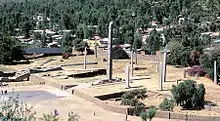 | Tigray Region 14°7′48.684″N 38°43′6.996″E | — | 15; 1980; i, iv | The ruins of the city of Aksum, dating from the 1st to the 13th century, mark the heart of ancient Ethiopia and what was the "most powerful state between the Eastern Roman Empire and Persia". It includes monolithic obelisks, giant stelae, royal tombs, and ruins of former castles.[4] |
| Fasil Ghebbi | 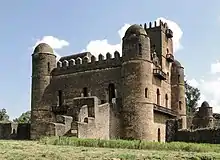 | Amhara Region 12°36′24.912″N 37°27′58.212″E | — | 19; 1979; ii, iii | The fortress was the residence of the Ethiopian emperors during the 16th and 17th century. The city remains, which feature buildings with Hindu and Arab influences, were later remodelled with Baroque-style architecture by Jesuit missionaries.[5] |
| Harar Jugol, the Fortified Historic Town | 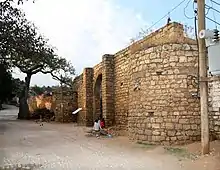 | Harari Region 9°18′32″N 42°8′16″E | 48 (120) | 1189; 2006; iv, v | The city is on a plateau and surrounded by gorges and savanna. It contains 82 mosques, 102 shrines, and unique interior design in the townhouses. Harar is said to be the fourth-holiest city of Islam.[6] |
| Konso Cultural Landscape | 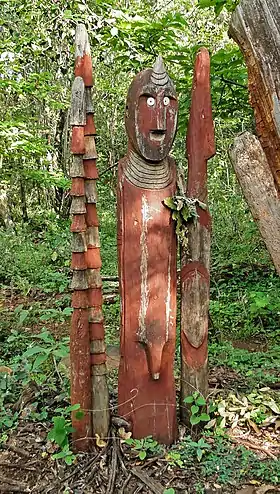 | Southern Nations, Nationalities, and People's Region 5°18′0″N 37°24′0″E | 14,000 (35,000) | 1333; 2011; iii, v | The site features 55 kilometres (34 mi) of stonewalled terraces and fortified settlements in the Konso highlands of Ethiopia.[7] |
| Lower Valley of the Awash | 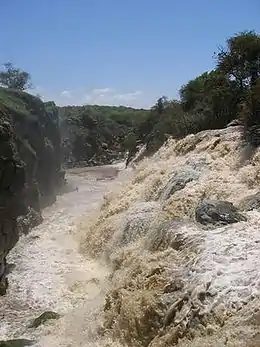 | Afar Region 11°6′0.216″N 40°34′45.804″E | — | 10; 1980; ii, iii, iv | Palaentological findings from at least four million years ago, such as Lucy, give evidence of human evolution.[8] |
| Lower Valley of the Omo |  | Southern Nations, Nationalities, and People's Region 4°48′0″N 35°58′0″E | — | 17; 1980; iii, iv | The prehistoric site near Lake Turkana is the location of many fossil findings, such as Homo gracilis.[9] |
| Rock-Hewn Churches, Lalibela |  | Amhara Region 12°1′45.66″N 39°2′25.512″E | — | 18; 1978; i, ii, iii | The site contains twelve medieval rock hewn churches from the 13th century.[10] |
| Simien National Park |
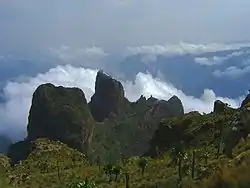 | Amhara Region 13°11′0″N 38°4′0″E | 22,000 (54,000) | 9; 1978; vii, x | The eroded Ethiopian plateau comprises jagged mountain peaks, deep valleys, and sharp precipices dropping about 1,500 m (4,900 ft).[11] The decrease of the Walia Ibex, bushbuck, and bushpig populations, as well as an increase of the human population in the park prompted the World Heritage Committee to place it on their List of World Heritage in Danger in 1996.[12] |
| Tiya |  | Southern Nations, Nationalities, and People's Region 8°26′5.676″N 38°36′43.56″E | — | 12; 1980; i, iv | The archaeological site contains 36 monuments, which includes 32 carved stelae covered with symbols hard to decrypt.[13] |
Tentative list
In addition to sites inscribed on the World Heritage List, member states can maintain a list of tentative sites that they may consider for nomination. Nominations for the World Heritage List are only accepted if the site was previously listed on the tentative list.[14] As of 2014, Ethiopia recorded five sites on its tentative list. The sites, along with the year they were included on the tentative list are:[2]
- Bale Mountains National Park (2008)
- Dirre Sheik Hussein Religious, Cultural and Historical Site (2011)
- Holqa Sof Omar: Natural and Cultural Heritage (Sof Omar: Caves of Mystery) (2011)
- Gedeo Mixed Cultural and Natural Landscape (2012)
- Melka Kunture and Bachilt Archaeological Site (2012)
References
- "The World Heritage Convention". UNESCO. Retrieved September 17, 2010.
- "Ethiopia – Properties inscribed on the World Heritage List". UNESCO. Retrieved July 29, 2014.
- "Report of the Rapporteur". UNESCO. October 9, 1978. Retrieved July 12, 2014.
- "Aksum". UNESCO. Retrieved 28 May 2010.
- "Fasil Ghebbi, Gondar Region". UNESCO. Retrieved 28 May 2010.
- "Harar Jugol, the Fortified Historic Town". UNESCO. Retrieved 28 May 2010.
- "Konso Cultural Landscape". UNESCO. Retrieved 17 August 2011.
- "Lower Valley of the Awash". UNESCO. Retrieved 28 May 2010.
- "Lower Valley of the Omo". UNESCO. Retrieved 28 May 2010.
- "Rock-Hewn Churches, Lalibela". UNESCO. Retrieved 28 May 2010.
- "Simien National Park". UNESCO. Retrieved 1 August 2010.
- "Simien National Park – Threats to the Site (1996)". UNESCO. Retrieved 11 September 2011.
- "Tiya". UNESCO. Retrieved 28 May 2010.
- "Tentative Lists". UNESCO. Retrieved July 12, 2014.

